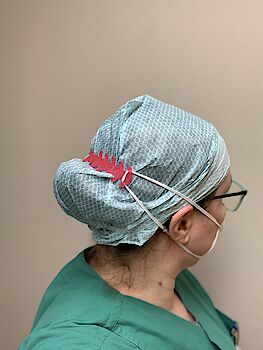A large part of the population is currently making their first experiences with mouth and nose protection masks. For hospital and nursing staff, these have long been part of their everyday work. Especially when treating COVID-19 patients, so-called FFP3 masks are also used, which must fit tightly and airtight and are often worn for many hours. But one thing is the same for everyone: after some time, the pressure from the thin rubber bands behind the ears becomes a constant irritation and can leave painful pressure points.
However, the wearing comfort can be significantly improved by using a small aid: An extension of the elastic bands is placed at the back of the head and relieves the pressure on the ears so that they no longer bend and thus no longer cause irritation or pressure points. Since the mask extensions are easy to produce, many makers and hobbyists support doctors and nurses with designs they have developed themselves, which can be printed in 3D.
In cooperation with Rebecca Tschorsch, specialist in anaesthesiology at the Charité Berlin, the Micro Factory of the Einstein Center Digital Future (ECDF) supports the project with the existing infrastructure and its know-how. Based on the preliminary work of Lam Wai Mars (www.livingees.com) and Suraky (https://www.thingiverse.com/Suraky/about), who have made their 3D printable templates freely available, Friedrich Schmidgall, head of the ECDF Micro Factory, has developed his own model for mask extensions. "After receiving feedback from the clinical users of the Charité, I made some minor adjustments. In addition, our central further development is that our model can be produced with the Laser Cutter," he explains.
Manufacturing with the Laser Cutter enables much faster production compared to the 3D printer. Another advantage is that the laser cutter can be used to process thin, tear- and break-resistant material (e.g. polypropylene). "This makes the mask extensions light, flexible and robust," says Friedrich Schmidgall.
Plans of the mask extensions for production with a laser cutter can be downloaded here: https://www.thingiverse.com/thing:4357878
Even without a laser cutter, such mask extensions can be produced from old plastic folders or other flexible material, for example: Just print the template below, stick it on a folder or similar and cut it out with scissors. Take care not to create sharp edges (if necessary, sand them down with a nail file or carefully melt the edges with a lighter)
Template for printing on DIN A4: https://www.thingiverse.com/download:8169263

